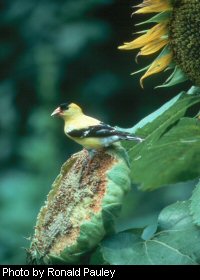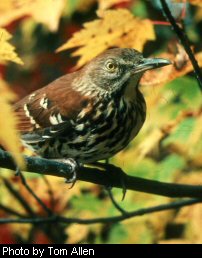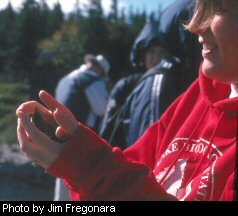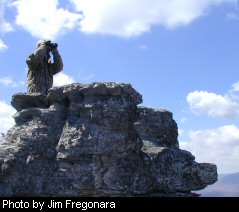

Birdwatching For All SeasonsBy Rob Tallman
SUMMERFor excellent summer birding, the Monongahela National Forest is the place to be. The Mon, as it is sometimes affectionately called, encompasses nearly one million acres of some of the most scenic and diverse areas of the Mountain State. In addition to windswept mountaintops, a variety of habitats exist including vast expanses of northern hardwood forests, high elevation swamps, nearly pure stands of red spruce and small grasslands. Because of its high elevations, the Mon is a great place to view some unique bird species more associated with northern latitudes. Many colorful and interesting species of birds can be observed within the northern hardwood forest including northern goshawk, Swainson's thrush, hermit thrush, veery , and magnolia, black-throated blue and black-throated green warblers. High elevation swamps or bogs within the Mon are home to the northern harrier, Nashville warbler, common snipe, and the yellow-bellied, olive-sided and alder flycatchers. Numerous mountaintops within the Mon, such as those along Cheat and Shavers mountains are covered in almost pure stands of red spruce. Within these red spruce forests, the northern saw-whet owl, yellow- rumped and blackburnian warblers, purple finch, golden-crowned kinglet and the winter wren exist. Although not large in area, the many small grassy balds or sods are home to some interesting grassland species. Birds such as the bobolink, vesper sparrow and savannah sparrow can be found in many of these high elevation fields. These are only just a few of the wonderful areas and species to observe within the Mon. FALLFall in West Virginia is a time for bird migration. Nesting is over for the season and the neotropical migrants that winter in Central and South America head south. The migrants that nested here in the state are leaving and those species that nested to Two of the best places to visit during fall migration are the Allegheny Front Migration Observatory and the Hanging Rock Hawk Tower. The Allegheny Front Migratory Observatory bird banding station located on Dolly Sods near the Red Creek Campground has been in continuous operation for 44 years. During that time the highly dedicated volunteers of the Brooks Bird Club that operate the station have banded over 188,000 birds representing 119 species. Many of the birds banded here are seen in West Virginia only during migration. The banding station also provides a good opportunity to see, in hand, many species that nest far to the north including the gray-cheeked thrush, Cape May warbler, bay-breasted warbler, blackpoll warbler, Connecticut warbler and the Wilson's warbler. In addition, you can also see many birds that do nest in West Virginia. Another great feature of the Observatory is the chance to see warblers up close in their fall plumage, which can make identification tricky- even for expert ornithologists. The banding station is open every morning from mid-August to mid-October. The Hanging Rock Hawk Tower offers an opportunity to view a different type of bird in migration: raptors. Raptor is a collective term used to describe owls, hawks, falcons and eagles. Species from each of these groups can be observed in the fall, on the right day with the right weather conditions at the Hanging Rock Hawk Tower. Late September usually offers the best chance to view these birds of prey. Species that may be seen include the bald eagle, golden eagle, northern harrier, osprey, peregrine falcon and most of the eastern hawk species including red-tailed, red-shouldered, broad-winged, sharp-shinned and Cooper's. On a good day in September, hundreds of birds can be seen migrating along the crest of Peter's Mountain. A fall day at either the Observatory or the Hanging Rock Hawk Tower can provide some excellent birding and the opportunity to view some of the state's most extraordinary scenery. WINTERMost think of winter as a slow time for birding. Indeed all of our colorful migrant warblers, vireos and tanagers have gone south and only a few wintering species can occasionally be heard singing. The woods and fields are silent and bird life seems almost at a standstill. Winter is the best time, however, to see migratory and wintering waterfowl. More than 30 species of waterfowl have been reported from West Virginia. Some species live here all year, such as the wood duck, Canada goose and mallard. All of the state's rivers, reservoirs and small impoundments serve as resting or feeding areas for migratory waterfowl, as long as they remain free of ice. Some good places to look are the state's major rivers: the Ohio, Kanawha and Monongahela , especially near locks and dams; and the Tygart , Little Kanawha , Potomac, Greenbrier , New, Gauley , Guyandotte and Tug Fork rivers. Other smaller rivers and streams are good places to look also, but normally the flocks of waterfowl will be in smaller numbers. Many large reservoirs around the state also serve as major feeding and resting areas for waterfowl. Reservoirs such as Mount Storm, Tygart , Stonewall Jackson, Burnsville, Sutton, Summersville , Bluestone , R. D. Bailey, East Lynn and Beech Fork Lakes provide good waterfowl viewing throughout the winter. Small impoundments such as those found on Burches Run, Conaway Run, Woodrum , Upper Mud River, Berwind Lake, Teter Creek, and Sleepy Creek Wildlife Management areas provide good waterfowl viewing as long as they don't freeze over. Other bird species to keep an eye out for when visiting these areas are the many species of gulls and sandpipers along with our national symbol – the bald eagle. Bald eagle sightings have been increasing in West Virginia the last several years. Sightings are recorded from all major waterways and many of our reservoirs every winter. SPRINGSpring is the prime time for birding in the Mountain State. The land is alive with bird song and flashes of color. More than 75 species of birds are known to breed in West Virginia. Many of these are neotropical migrants that winter in Central and South America. In fact, because of the excellent habitat and great numbers of neotropical migrants that nest in the state, West Virginia is considered an important source population of these neotropical migrants for surrounding states, where populations are declining. To find excellent spring birding in the Mountain State, simply close your eyes and point to any spot on a map of West Virginia and neotropical migrants will be there. Some of the best areas, however, are our numerous state parks, state forests and wildlife management areas. From summer tanagers at Cabwaylingo State Forest to golden-winged warblers at Springfield WMA, and Baltimore orioles at Hillcrest One of the more popular springtime birding destinations is Kanawha State Forest, a particularly diverse area. Because of its geographic location, it is a crossover area for many northern and southern species of plants and animals, including birds. Nineteen species of warblers are known to nest in the area and some of the highest cerulean warbler densities in the state can be found here. Another good springtime birding spot is Short Mountain WMA. Various species of warblers, vireos and flycatchers can be found here as well as many interesting wetland species. Bird watching in West Virginia is excellent at any time of the year. So no matter what season it is--summer, fall, winter or spring --opportunities await to view many species of birds in some of the most scenic areas of the Mountain State. For additional information on birding opportunities, check out the DNR website at wvdnr.gov. Rob Tallman is a wildlife biologist with the DNR's Wildlife Diversity Program. |
 The Mountain State is home to a great abundance and diversity of bird life. We are blessed with hundreds of thousands of acres of public lands and waters in which to view the more than 300 species of birds known to breed and winter in the state or migrate through. Because West Virginia has such diverse habitat types and so many great places to view the numerous species of birds found here, it's a challenge to make a list of the state's best birding spots. Having a general idea of where and when to look, however, can provide an enjoyable birding experience and may provide for some rare and unique species sightings.
The Mountain State is home to a great abundance and diversity of bird life. We are blessed with hundreds of thousands of acres of public lands and waters in which to view the more than 300 species of birds known to breed and winter in the state or migrate through. Because West Virginia has such diverse habitat types and so many great places to view the numerous species of birds found here, it's a challenge to make a list of the state's best birding spots. Having a general idea of where and when to look, however, can provide an enjoyable birding experience and may provide for some rare and unique species sightings.  our north are passing through on their journey southward. All of these birds on the move provide for great birding opportunities.
our north are passing through on their journey southward. All of these birds on the move provide for great birding opportunities.  Other species, such as the common loon, snow goose and ring-necked duck are only reported occasionally, or in very small numbers during the winter.
Other species, such as the common loon, snow goose and ring-necked duck are only reported occasionally, or in very small numbers during the winter.  WMA to white-eyed vireos at Cedar Creek State Park, there are a multitude of places to visit and bird species to see.
WMA to white-eyed vireos at Cedar Creek State Park, there are a multitude of places to visit and bird species to see.